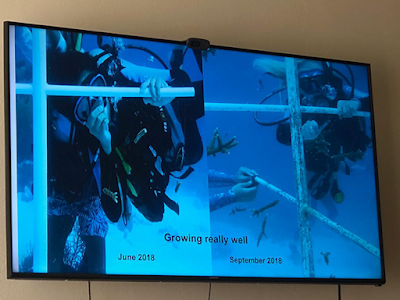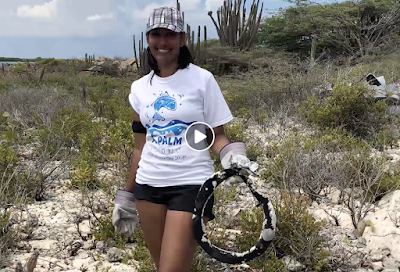Fall is here, and with it comes striking autumn colors, cooler weather and all things pumpkin flavored! In the U.S., kids and kids at heart start planning their costumes for Halloween, and homes are adorned with scary skeletons and bright orange décor.
But 24/7 and 365 days per year, there are creatures living in the depths of our oceans that put our attempts at a spooky celebration to shame. The appearance of some of these very unique ocean dwellers could send a shutter down the spines of even diehard haunted house lovers. Here are some unique critters living in the deep sea!
Sarcastic Fringehead
Looking like something out of a horror movie from the 1980s, the Sarcastic Fringehead is a foot-long fish that lives off the Pacific Coast of North America. When unthreatened, the Fringehead is not that menacing. But if a marine predator (or stray human hand) attempts to dislodge a Fringehead from its home, the fish will race into action, brandishing its frightening predator-like teeth.
At the first sign of danger, Fringeheads employ their enormous mouths and needlelike teeth for defense. Initially, they emit only a warning, which is accomplished by the flexing and snapping of their jaws. Fringeheads do not typically attack humans, but we suggest keeping your fingers out of their personal space.
Check out the Sarcastic Fringehead on video!
Black Dragonfish
Another 80’s horror flick throwback, the Black Dragonfish resembles the monsters from the Alien movies. Fortunately, you really don’t have much to fear from the Black Dragonfish due to their diminutive size. The females are some 15 inches long (40 cm). That may sound like a fairly good size, but a lot of that length comes from their long, tail-like structure. Their mouths, by comparison, are rather little. They do possess long fangs, utilized for catching other fish.
Black Dragonfish can produce their own light, which is handy since they reside in the black recesses of the ocean. You can find these tiny terrors more than a mile beneath the waters (2,000 meters). Unlike most bioluminescent predators, the Black Dragonfish glows and can see its own light.
Common Fangtooth
Aptly named, Fangtooths have mouths that are full of long, pointy teeth, which are perfect for catching and trapping prey of just about any size. Common Fangtooth are deep-sea predators that have been recorded at depths of over 16,000 feet (4877 m)!
Though they spend most of their time in the deep, Common Fangtooth are known to migrate toward the surface at night, following their preferred prey of crustaceans and other fishes. Common Fangtooth are more active than many other deep-sea fishes and seek out food, rather than lying in wait.
Common Fangtooth do not have light producing organs or cells for communication, or to attract prey. Instead, they rely heavily on their sense of smell and benefit from even the slightest bit of sunlight that may make it down to the depths.
Although the Fangtooth appears menacing, they are actually quite small. The maximum length of a Fangtooth is a mere six inches (15 cm).
Frilled Shark
Sometimes called a “living fossil” because it hasn’t changed much since prehistoric times, the eel-like Frilled Shark is rarely seen by humans… and we should be very relieved!
The Frilled Shark’s mouth is as terrifying as that of a Great White. It’s lined with 25 rows of backward-facing, trident-shaped teeth—300 in all. The Frilled Shark’s mouth looks larger than that of other sharks because its jaws terminate at the back of the fish's head instead of underneath the skull.
The Frilled Shark has red frilled gills, with the initial gill slit across the throat, as if it were cut with a knife.
Watch the creepy Frilled Shark here!
Goblin Shark
Not so pretty in pink, the Goblin Shark does not get its color from pink pigments in its skin. In fact, this shark has a translucent dermis (skin) that enables us to see the oxygenated blood within its capillaries. Its snout and tooth structure are just as unique. An overhanging, tremendously elongated yet flattened snout forms a blade-like appearance. The Goblin Shark’s long, slender, exceptionally sharp fang-like teeth are connected to its protruding jaw. To make matters even more intricate, the snouts of these sharks are sprinkled with tiny receptors that pick up electric fields.
One of the most interesting features of this shark is the way it bites its food source. Its mouth actually extends outward from its body and can move independently.
Watch the Goblin Shark in action!
Viperfish
One of the most unusual-looking creatures of the sea, the Viperfish is a fierce predator. It’s easily recognized by its large mouth and sharp, fang-like teeth. In fact, the fangs are so large that they often exceed its mouth size. Instead, they curve back very close to the fish’s eyes. The Viperfish uses these sharp teeth to impale its prey while swimming at it at high speeds.
Accompanying this outlandish dental structure, the Viperfish also possesses an elongated dorsal spine that is tipped with a light-producing organ. Viperfish can flash the light on and off, utilizing it like a lure.
Viperfish hunt in the darkness. They have been observed hanging motionless in the water, waving their “lures” overhead. The have a hinged skull, which can be rotated upward, allowing them to swallow unusually large victims.
Check out this video featuring the Viperfish.
Vampire Squid
With a scientific name that means "the vampire squid from hell," you'd expect the Vampire Squid
(Vampyroteuthis infernalis) to be a fearsome predator terrorizing the deep. Despite its demonic look, that isn't the case; instead, the Vampire Squid collects and consumes drifting particles. It uses eight “arms” and two long, sticky filaments to grab its food.
The body composition of the Vampire Squid is similar to that of a jellyfish. They have the largest eye-to-body ratio of any animal in the world.
Black Swallower
Capable of swallowing prey twice its size in a single bite, the Black Swallower creeps up behind its prey, trapping its meal by the tail in its sharp, interlocking teeth. The Swallower then coils the prey into its expanding stomach, and sets off in search of its next victim. The Swallower’s bloated and stretched stomach extends so far down in fact, that the stomach tissue becomes transparent.
Atlantic Wolffish
Last but certainly not least on our list, is the Atlantic Wolffish. Atlantic Wolffish are vicious predators. Their eel-like bodies, large teeth, big heads and powerful jaws are used to eat hard-bodied prey such as sea urchins, crabs and snails. Like eels, they favor rocky ocean bottoms and seaweed beds where they can hide. These solitary fish grow up to five feet long (1.5 m) and can weigh an astounding 40 pounds (18 kg). Wolffish have a unique, natural antifreeze in their bodies, which keeps their blood moving fluidly in their very cold habitat.
The Atlantic Wolffish is listed as “special concern” under the Species at Risk Act, and are not often seen by humans. However, if you happen to encounter one, or manage to reel one in while fishing, watch out: "When hauled out of the water [the Wolffish] snaps like a bulldog and with good aim at anything in its way… hands, an oar, or at other fish among which it is thrown, and it can inflict a serious bite," reports the Gulf of Maine Research Institute, which adds that they've received reports of Wolffish swimming in shallower rocky waters and making a "furious attack" on people wading there. YIKES!
What is your favorite creepy creature? Tell us about it below!































